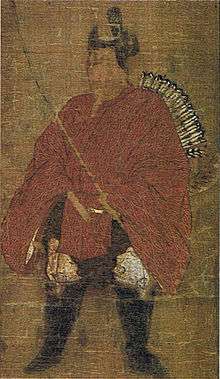Minamoto no Tameyoshi
Minamoto no Tameyoshi (源 為義, 1096 – August 17, 1156) was head of the Minamoto samurai clan during his lifetime, and grandson of Minamoto no Yoshiie; he led the Minamoto in the Hōgen Rebellion. Tameyoshi is also known as Mutsu Shirō (陸奥 四郎).
Minamoto no Tameyoshi | |
|---|---|
 Minamoto no Tameyoshi, from the collection of Shiramine Shrine | |
| Native name | 源為義 |
| Born | 1096 |
| Died | August 17, 1156 |
| Buried | Gongen-ji, in Sujakuurahata-chō, Shimodagyō-ku, Kyōto |
| Battles/wars | Hōgen Rebellion |
Though most famous for his involvement in the Hōgen Rebellion, Minamoto No Tameyoshi is also said to have intervened in a number of other conflicts earlier in his life. Around 1113, the ongoing rivalry between the warrior monks of Mii-dera and Enryaku-ji erupted into outright violence in the streets of Kyoto. Though the palace guard mobilized quickly to protect the Emperor, it is said that Tameyoshi, with a handful of mounted samurai, drove the mobs away himself.[1]
Upon being defeated in the Hōgen Rebellion, Tameyoshi took the tonsure and was released into the custody of his son Minamoto no Yoshitomo who then had him beheaded.[1]:256 This was an unprecedented breaking of Buddhist values in Japan, yet no one in the court berated Yoshitomo for his actions at the time until after his death.
Family
- Father: Minamoto no Yoshichika (源義親, ?–1108?)
- Mother: unknown
- Wife: daughter of Fujiwara no Tadakiyo (藤原忠清の娘)
- 1st son: Minamoto no Yoshitomo (源義朝, 1123–1160)
- Concubine: daughter of Rokujō no Shigesugu (六条重俊娘)
- 2nd son: Minamoto no Yoshikata (源義賢, ?–1155)
- 3rd son: Minamoto no Yoshihiro (源義広, ?–1184), also called "Shida Saburō Senjō" (志田三郎先生).
- Concubine: daughter of Minamoto no Motosane (源基実娘)
- 4th son: Minamoto no Yorikata (源頼賢, ?–1156)
- 5th son: Minamoto no Tamekata (源頼仲, ?–1156)
- 6th son: Minamoto no Tamemune (源為宗, ?–1156)
- Concubine: daughter of Kamo no Narimune (賀茂成宗娘)
- 7th son: Minamoto no Tamenari (源為成, ?–1156)
- Concubine: 'prostitute from Eguchi-jō (江口城), Settsu Province
- 8th son: Minamoto no Tametomo (源為朝, 1139–1170)
- 9th son: Minamoto no Tamenaka (源為仲, 1142–1156)
- Children with unknown mother:
- 10th son: Minamoto no Yukiie (源行家, 1143–1186)
- 11th son: Minamoto no Otowaka (源乙若, 1144–1156)
- 12th son: Minamoto no Kamewaka (源亀若, 1146–1156)
- 14th son: Minamoto no Koreyoshi (源維義, ?–?)
- 15th son: Minamoto no Yorisada (源頼定, 1151–?)
- 17th son: Minamoto no Masachika (源正親, 1153–?)
- Son: Minamoto no Norisato (源仙覚, ?–?)
- Son: Minamoto no Takakimi (源天王, ?–?)
- Daughter: "Lady of Mino" (美濃局, ?–?)
- Daughter: Tori-in-zen-ni (鳥居禅尼, ?–?)
- Daughter: wife of Sasaki Hideyoshi (佐々木秀義室)
- Daughter: wife of Fujiwara no Mitsutaka (藤原光隆室)
- Wife: daughter of Fujiwara no Tadakiyo (藤原忠清の娘)
See also
References
- Sansom, George (1958). A history of Japan to 1334. Stanford University Press. pp. 272–273. ISBN 0804705232.
- trans. Varley, Paul H. (1980). "A Chronicle of Gods and Sovereigns 'Jinnō Shōtōki' of Kitabatake Chikafusa". New York: Columbia University Press.